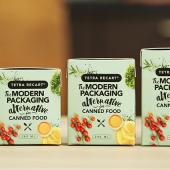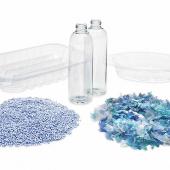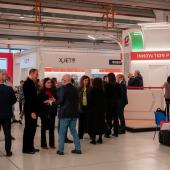The rebirth of the sense of wonder
Let’s try once again to experience wonder, to dwell in the spaces of the unusual, the exceptional, despite the fact that in our globalized and interconnected world, where everything is consumed in a flash and immediately forgotten, building a “time” for dreams, hopes, feelings no longer seems truly possible. Stefano Lavorini
This might constitute the challenge of Expo Milano that – over and beyond the shady dealing and the controversies - has seen many men and women invest intelligence and vigour to build a great moment of education and entertainment, an opportunity for the entire country.
How Expo will be, obviously, no one can tell at this point in time, but what is certainly clear here and now is who fully believed in it fully and who has fully committed themselves to it. Two examples, limiting ourselves to the host country: Coop and Conai. Stefano Lavorini
The Future Food District
“Nourishing the planet, energy for life” are words that belong to the Coop tradition and the Coop story, as Marco Pedroni, president of Coop Italia, had the opportunity to highlight at a recent meeting with the press.
«For us, Expo is not a fair, but an occasion for sharing contents, developing relationships, presenting technology and, most importantly, bringing to light those social aspects that are ours: for us food means food that is good and safe for all, and that “for all” also includes the 10 billion people who will inhabit this planet in thirty years».
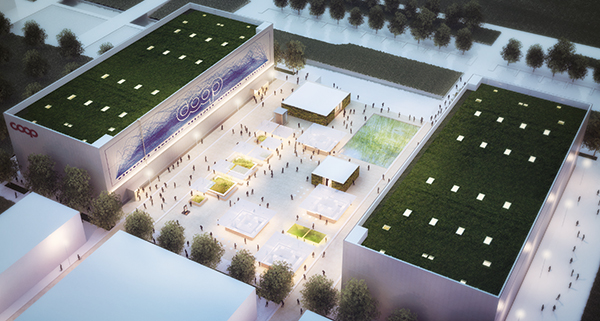
Food District Plaza of the Future, with food distribution points, exhibition spaces and a series of green troughs with shaded seating alongside of the access to the Supermarket of the Future.
Inside the plaza you also find the COOP Exhibition Area, with a Vertical Farm and Canopy of Alghe. The pavilion facade will feature a Vertical Plotter and an automated writing system that will display data processed in real time on this huge canvas.
Expo’s Future Food District... how we’ll buy, how we’ll eat and who will eat the food and products in a more or less distant future, before they reach our table.
A daunting challenge. That’s how Pedroni defined the issue, without mincing words. And he’s right, in that the Future Food District is an experiment that makes a reality of one possible scenario for the future of retail, created with the help of the MIT Senseable City Laboratory and the firm Carlo Ratti Associati.
It is, in other words, a real supermarket - not one in a lab - where it is possible to live a real consumer experience, integrated with the Exhibition Area, a multipurpose structure that looks to a still distant horizon.
«It’s not what we predict the supermarket of the future will be - the Coop president was careful to point out – but what we would like it to be. In that ‘what we would like’ is contained our notion of an equitable market, a social market, an open space, not what technology will push toward based on some sort of automatism. But also a modest ambition of ours to influence what may come.
In the meantime, it’s a mix of history, traditions and future. We’ve had markets for centuries, the market squares where society and culture are indistinguishable from commerce. And we would like this dimension of history and culture to also be present in the supermarkets of today, “well-oiled machines” that they are, with their many products and complex supply chains. We want a future in which the dimension of the market square is reunited with that of functionality, and therefore with technology. This is the concept with which we began».
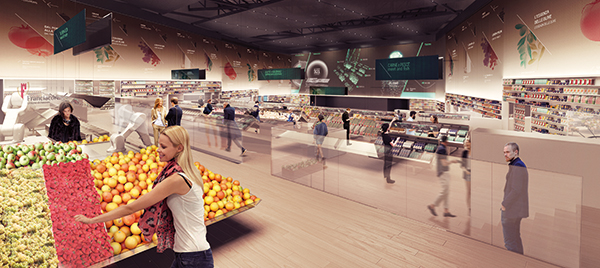
The Supermarket of the Future. The supermarket comprises a vale of products. This space features a digital level above the products on display, via which the visitors can interact with the food.
The products and packaging are those currently available in supermarkets, in particular the advanced solutions that encapsulate a particular vision of the future.
A human touch. The supermarket that we will see at Expo is conceived as a traditional marketplace, without high shelves, allowing a panoramic view of the whole. Thus, products that speak, a layout coherent with this concept, augmented reality labels capable of translating information into a simple language…
2,500 square meters on two floors, set to welcome, according to estimates, 30 thousand visitors per day, where 40 workers at the Coop Lombardia POP will be employed for six months, rather than temporary workers.
As Francesca Randelli, manager of Coop Tirreno, recounted, the idea arose from within Coop before its participation at Expo, resulting from an innovation contest in which 80 employees under 35 participated, and in particular from the GeoCoop project, which sought to emphasize values like transparency and sincerity, indispensable for informed consumer decision-making.
«What we’ve managed to create - continues Pedroni - is not a hypertechnological pavilion, because we at Coop wanted to move in the opposite direction, one in which technology is at the service of people, and not the other way around».
The supermarket is organized around 5 sectors, which became five pathways, each of which begin with fresh and very fresh products, gradually progressing through increasingly processed products: milk and dairy, coffee and tea, meat and fish, fruit and vegetables and wine… this also in order to communicate to consumers the concepts of supply chain and the continuity of processes.
On the shelves will be available both Coop brand products and those of 90 suppliers, largely Italian or that produce in Italy.
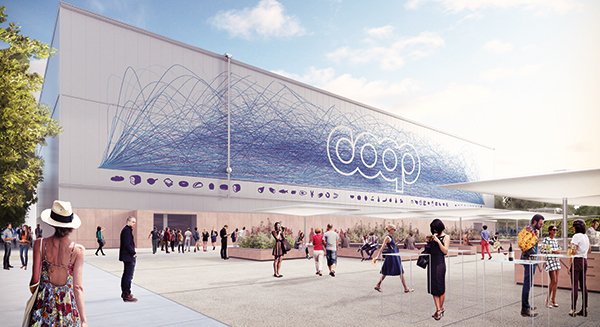
Food District Plaza of the Future, seen from head height
The huge wall featured by the Vertical Plotter dominates the entrance to the plaza. Rest areas and kiosks offer a public space with facilities for EXPO visitors to EXPO visitors.
The Future Food District is an experiment that makes reality of one possible scenario for the future of retail. It is a real supermarket, one in which anyone who wishes can have a real buying experience. But it is also part of the Exhibition Area, a multipurpose structure looking to an even further horizon”.
It’s there but you don’t see it. All the foods - more than 1500 products - will communicate the information they contain, and it will be the visitor who asks the questions… with a wave of the hand: “augmented” information, for the consumer that takes control.
«The future of the market could start with the story of its products - agreed Carlo Ratti, director of the MIT Senseable City Laboratory. Indeed, every product carries with it its story, which nonetheless reaches the consumer in a fragmented and partial form. In a not too distant future, on the other hand, the products themselves could be capable of telling their stories. The information will be contained in smart labels and subsequently transmitted in real time to the user. We could discover everything there is to know about an apple: the tree from which it was harvested or its voyage from there to the shelf, the carbon dioxide that it produced or the processes it underwent, to the benefit of more informed and conscientious consumption».
Ratti then joked about how hard it is to predict the future («history shows that nobody’s ever succeeded at it»). «What we can do today is experiment... and some of the ideas that will succeed will help us build the future. That’s what we have done: not a window to the future, which would be an exercise in futility, but a testing out of concrete solutions».
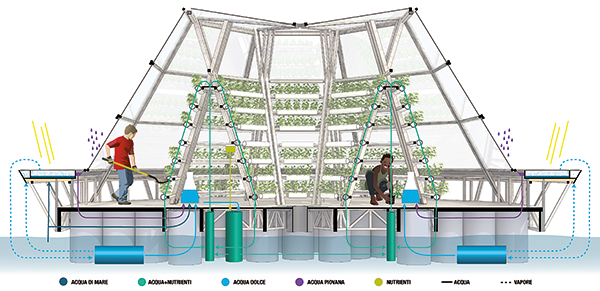
The Jellyfish Barge modular floating greenhouse reproposes the natural phenomenon of solar desalination to generate 150 litres of clean freshwater from salt water or brine per day. A project of the University of Florence with a working prototype in the Navicelli canal between Pisa and Livorno.
Guided tour. In order to discover more, let’s enter the Future Food District.
Consumers access the supermarket from a hallway, finding themselves in a Coop POP, as indicated by an infographic on the wall that details its history, but they will also discover what is happening “behind the scenes”, in the warehouse.
This takes them to the upper floor, with a view of the products below, carefully arranged on tables ordered from the fresh products to processed ones.
Three levels of interaction are possible. The first enables obtaining information on the primary characteristics of a product; the second supplies the augmented label, detecting the origin of the raw materials making up the product, the presence of allergens, nutritional data per portion and environmental impact in terms of CO2 equivalence. Finally, the third level goes into detail about the history and characteristics of the food product.
«It’s as if the technology fades away, bringing us back to the old market and its social space», explains Ratti.
We also decided to use the external façade of the pavilion in order to display, thanks to an enormous plotter, what is happening inside the building and in other Coop supermarkets.
Finally, the plaza, a rest area where visitors will experience together episodic experiences (an installation dedicated to algae, a vertical farm)… In short, a place to spend time, together».
The expertise of Conai at the service of Expo and the community
Conai is a "flagship" of the national industrial system, both for the efficiency of the structure and organization (in 15 years it has generated € 15.2 billion of total benefits for Italy and, to date, 37,000 people work in the packaging waste processing sector and recycling industry), as well as for the excellent results obtained packaging collection and recycling.
Hence Conai’s presence at Expo 2015 was a must, the two authorities having concluded a Memorandum of Understanding to promote a program of Circular Economy during the Universal Exhibition.
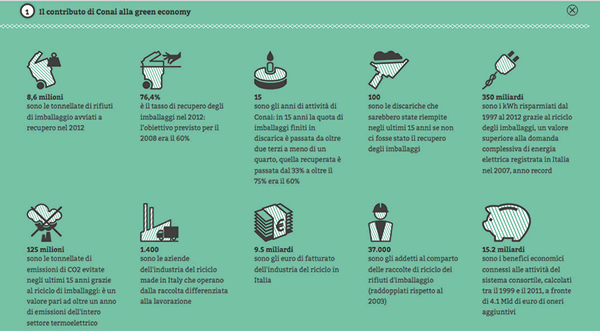
Figures that speak for themselves. From May to November, within the exhibition site, an estimated 17,000 t - between 70 and 80 tons per day with peaks of 130 t on weekends - of municipal and associable waste is liable to be produced. At least 40% of waste will be produced by the visitors, the remaining 60% by the exhibition areas, food service and catering.
Conai hence takes on the role of «interpreter of the importance of waste recycling via segregated collection, developing initiatives involving visitors and operators, prompting them to virtuous behaviour», declared Walter Facciotto, Conai General Manager, during the end of March press meeting.
We start from the most direct: panels and information materials will first of all explain how and where to dispose of waste (packaging and other), enabling the exploitation of the same via recycling. The segregated collection bar has been set the threshold of 70% of total waste, to be sent for recycling via the supply chain consortiums as well as for composting, while the segregated collection system for Milan Expo 2015 will be the same as that currently in force in the city, which comprises five fractions (paper and cardboard, glass, metal and plastic packaging, biowaste with food scraps and disposable products).
Aiming for complete transparency, the agreement between CONAI and Expo 2015 SpA also includes the implementation of an "environmental meter" in collaboration with AMSA-A2A Group, which will measure the economic, social and environmental benefits generated by a proper waste management through a series of indicators: CO2 emissions avoided, amount of waste rerouted from landfills and recycled per product category, secondary raw materials generated, water and energy saving ...
A series of videos in Italian and English will also illustrate the correct approach to segregated collection to be adopted within Expo, so as to ensure a quality collection, the minimizing of extraneous items and the recovery of the greatest amount of waste possible.
Lastly, to inform and educate the very young, the Consortium will organize an interactive game using 18 e-walls, offering educational material in the Children Park area.
In conclusion, disseminating good waste management practices and spreading a proper recycling culture exploiting the visibility of Expo entails offering an excellent opportunity for Italy to become an international benchmark in the subject.














